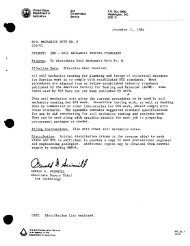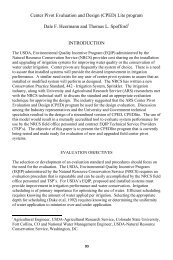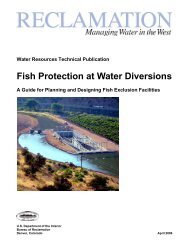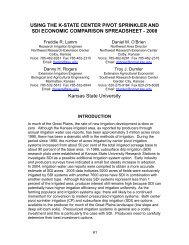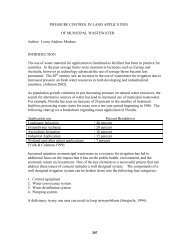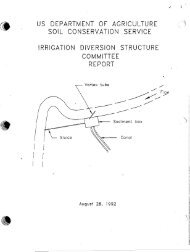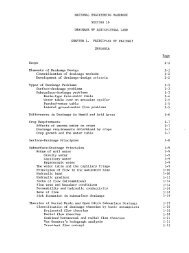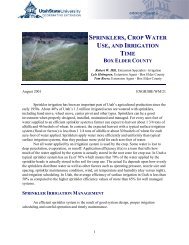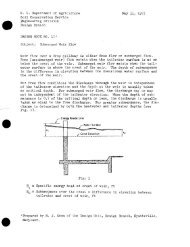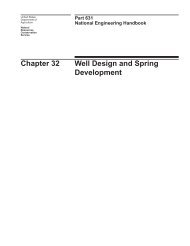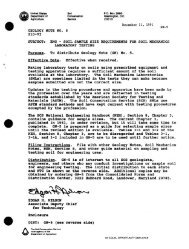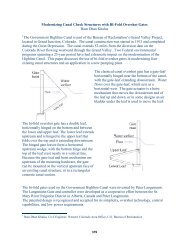Chapter 11: Sprinkle Irrigation - NRCS Irrigation ToolBox Home Page
Chapter 11: Sprinkle Irrigation - NRCS Irrigation ToolBox Home Page
Chapter 11: Sprinkle Irrigation - NRCS Irrigation ToolBox Home Page
You also want an ePaper? Increase the reach of your titles
YUMPU automatically turns print PDFs into web optimized ePapers that Google loves.
<strong>Chapter</strong> <strong>11</strong><br />
<strong>Sprinkle</strong> <strong>Irrigation</strong><br />
Adaptability<br />
<strong>Sprinkle</strong> irrigation is the application of water in<br />
the form of a spray formed from the flow of water<br />
under pressure through small orifices or nozzles.<br />
The pressure is usually obtained by pumping, although<br />
it may be obtained by gravity if the water<br />
source is high enough above the area irrigated.<br />
<strong>Sprinkle</strong> irrigation systems can be divided into<br />
two general categories. In periodic-move and fixed<br />
systems the sprinklers remain at a fixed position<br />
while irrigating, whereas in continuous-move systems<br />
the sprinklers operate while moving in either a<br />
circular or a straight path. The periodic-move systems<br />
include hand-move and wheel-line laterals,<br />
hose-fed sprinkler grid, perforated pipe, orchard<br />
sprinklers, and gun sprinklers. The dominant continuous-move<br />
systems are centerpivot and traveling<br />
sprinklers.<br />
With carefully designed periodic-move and fixed<br />
systems, water can be applied uniformly at a rate<br />
based on the intake rate of the soil, thereby preventing<br />
runoff and consequent damage to land and<br />
to crops. Continuous move systems can have even<br />
higher uniformity of application than periodic-move<br />
and fixed systems, and the travel speed can be adjusted<br />
to apply light watering that reduces or elimi-<br />
<strong>Sprinkle</strong> irrigation is suitable for most crops. It is<br />
also adaptable to nearly all irrigable soils since<br />
sprinklers are available in a wide range of discharge<br />
capacities. For periodic-move systems with proper<br />
spacing, water may be applied at any selected rate<br />
above 0.15 inch per hour (iph). On extremely finetextured<br />
soils with low intake rates, particular care<br />
is required in the selection of proper nozzle size,<br />
operating pressure, and sprinkler spacing to apply<br />
water uniformly at low rates.<br />
Periodic-move systems are well suited for irrigation<br />
in areas where the crop-soil-climate situation<br />
does not require irrigations more often than every 5<br />
to 7 days. Light, frequent irrigations are required<br />
on soils with low water holding capacities and shallow-rooted<br />
crops. For such applications, fixed or<br />
continuously moving systems are more adaptable;<br />
however, where soil permeability is low, some of the<br />
continuously moving systems, such as the centerpivot<br />
and traveling gun, may cause runoff problems.<br />
In addition to being adaptable to all irrigation<br />
frequencies, fixed systems can also be designed and<br />
operated for frost and freeze protection, blossom delay,<br />
and crop cooling.<br />
The flexibility of present-day sprinkle equipment,<br />
and its efficient control of water application make<br />
the method's usefulness on most topographic conditions<br />
subject only to limitations imposed by land<br />
use capability and economics.



